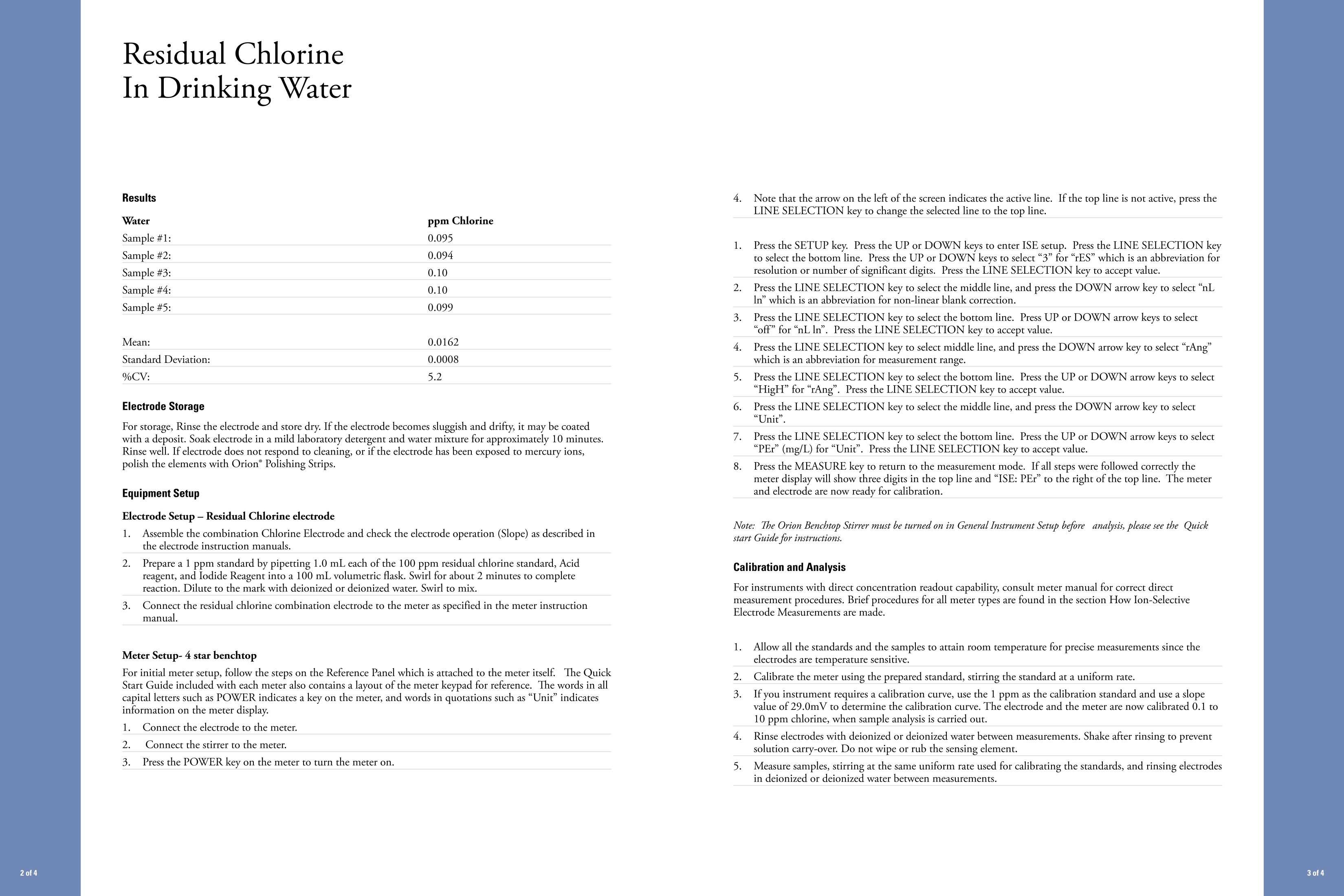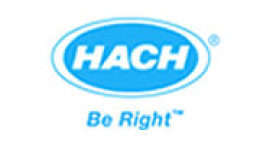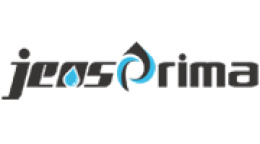方案详情文
智能文字提取功能测试中
Residual ChlorineIn Drinking WaterResidual ChlorineIn Drinking Water Residual ChlorineIn Drinking Water Star SeriesMethod Note M-1003-E03/05RevB ·Chlorine Introduction ·Water·Residual Chlo-rine Electrode(ISE) This procedure determines total residual chlorine in all waters and wastewaters regardless of color orturbidity. The direct concentration readout procedure measures from 0.1 and 10 ppm chlorine. Higherconcentrations are easily analyzed after dilution. The U.S. EPA has approved the electrode procedure.The Orion°9770BNWP Residual Chlorine allows total residual chlorine to be measured quickly andaccurately. This electrode method is EPA approved for drinking and wastewater analysis (EPA No. 330.5). Recommended Equipment Catalog# 1. 4 Star benchtop pH/ISE meter 11150002. Residual Chlorine electrode 9770BNWP3. Orion benchtop stirrer (or magnetic stir plate and bar) 096019 4. Benchtop electrode stand 11100015.Beakers (150 mL)6V.olumetric flask (100 mL)7. Pipette (1 mL)Required Solutions Catalog#1. Standard solution, 100 ppm 9770072. Iodine reagent for CL2 electrode 5 X5 977010 3. Acid reagent 475 mL 977011 4. Deionized water Calibration Standard Preparation 1. Transfer 100 mL of the 1 ppm standard into a 150 mL beaker and stir. Use this as the only standardused for calibration. 2. The slope used should be 29.0mV as verified in the slope check procedure in the electrode instructionsmanual. Sample Preparation 1. Store about 1 liter of fresh water just prior to the analysis into a beaker to maintain the consistency ofthe chlorine content in that particular “batch”of water. 2.Pipet 1.0 mL each of the acid reagent and Iodide Reagent into a 100 mL volumetric flask. Dilute tothe volume with the sample and mix thoroughly. Let the solution stand for about 2 minutes to allowcomplete reaction. Pour the contents of the flask into a beaker and stir. Cover the beaker with a watchglass. 3. Repeat this procedure three to five times to obtain five readings of the same for consistent results. Environmental InstrumentsWater Analysis Instruments166 Cummings CenterBeverly, MA 01915 USAM-1003-E 03/05 RevB248063-001 Toll Free:1-800-225-1480Tel:1-978-232-6000Dom. Fax:1-978-232-6015IntlFax:978-232-6031www.thermo.com/waterO 2005 Thermo Electron Corporation RegisteredIS O9001:2000 All rights reserved Results Water ppm Chlorine Sample #1: 0.095 Sample #2: 0.094Sample #3: 0.19 Sample #4: 0.10 Sample #5: 0.099 Mean: 0.0162 Standard Deviation: 0.00085.2 %CV: Electrode Storage For storage, Rinse the electrode and store dry. If the electrode becomes sluggish and drifty, it may be coatedwith a deposit. Soak electrode in a mild laboratory detergent and water mixture for approximately 10 minutesRinse well. If electrode does not respond to cleaning, or if the electrode has been exposed to mercury ions,polish the elements with Orion° Polishing Strips. Equipment Setup Electrode Setup -Residual Chlorine electrode 1.Assemble the combination Chlorine Electrode and check the electrode operation (Slope) as described inthe electrode instruction manuals. 2. Prepare a 1 ppm standard by pipetting 1.0 mL each of the 100 ppm residual chlorine standard, Acidreagent, and Iodide Reagent into a 100 mLvolumetric flask. Swirl for about 2 minutes to completereaction. Dilute to the mark with deionized or deionized water. Swirl to mix. 3 Connect the residual chlorine combination electrode to the meter as specified in the meter instructionmanual. Meter Setup-4 star benchtop For initial meter setup, follow the steps on the Reference Panel which is attached to the meter itself. The QuickStart Guide included with each meter also contains a layout of the meter keypad for reference. The words in all. capital letters such as POWER indicates a key on the meter, and words in quotations such as “Unitindicatesinformation on the meter display. 1. Connect the electrode to the meter. 2. Connect the stirrer to the meter. 3 Press the POWER key on the meter to turn the meter on. 4 Note that the arrow on the left of the screen indicates the active line. If the top line is not active, press theLINE SELECTION key to change the selected line to the top line. Press the SETUP key. Press the UP or DOWN keys to enter ISE setup. Press the LINE SELECTION keyto select the bottom line. Press the UP or DOWN keys to select “3”for“rES" which is an abbreviation forresolution or number of significant digits. Press the LINE SELECTION key to accept value. 2 Press the LINE SELECTION key to select the middle line, and press the DOWN arrow key to select“nLIn”which is an abbreviation for non-linear blank correction. 3 Press the LINE SELECTION key to select the bottom line. Press UP or DOWN arrow keys to select“off" for “nL In". Press the LINE SELECTION key to accept value. 4. Press the LINE SELECTION key to select middle line, and press the DOWN arrow key to select “rAng”which is an abbreviation for measurement range. 5 Press the LINE SELECTION key to select the bottom line. Press the UP or DOWN arrow keys to select“HigH” for "rAng". Press the LINE SELECTION key to accept value. 6 Press the LINE SELECTION key to select the middle line, and press the DOWN arrow key to select“Unit”. 7.Press the LINE SELECTION key to select the bottom line. Press the UP or DOWN arrow keys to select“PEr”(mg/L) for “Unit". Press the LINE SELECTION key to accept value. 8 Press the MEASURE key to return to the measurement mode. If all steps were followed correctly themeter display will show three digits in the top line and“ISE: PEr" to the right of the top line. The meterand electrode are now ready for calibration. Note: The Orion Benchtop Stirrer must be turned on in General Instrument Setup before analysis, please see the Quickstart Guide for instructions. Calibration and Analysis For instruments with direct concentration readout capability, consult meter manual for correct directmeasurement procedures. Brief procedures for all meter types are found in the section How Ion-SelectiveElectrode Measurements are made. 1.Allow all the standards and the samples to attain room temperature for precise measurements since theelectrodes are temperature sensitive. 2.Calibrate the meter using the prepared standard, stirring the standard at a uniform rate. 3. If you instrument requires a calibration curve, use the 1 ppm as the calibration standard and use a slopevalue of 29.0mV to determine the calibration curve. The electrode and the meter are now calibrated 0.1 to10 ppm chlorine, when sample analysis is carried out. 4. Rinse electrodes with deionized or deionized water between measurements. Shake after rinsing to preventsolution carry-over. Do not wipe or rub the sensing element. 5. Measure samples, stirring at the same uniform rate used for calibrating the standards, and rinsing electrodesin deionized or deionized water between measurements. www.thermo.com of of ofof 本文章详细介绍了饮用水中余氯的测定,包括校准液、水样的准备,校准和测量过程,以及电极和仪表的维护等内容。
关闭-
1/2

-
2/2

产品配置单
赛默飞中国实验室产品事业部为您提供《饮用水中消毒剂检测方案(紫外分光光度)》,该方案主要用于饮用水中消毒剂检测,参考标准《暂无》,《饮用水中消毒剂检测方案(紫外分光光度)》用到的仪器有null。
我要纠错
相关方案


 咨询
咨询



